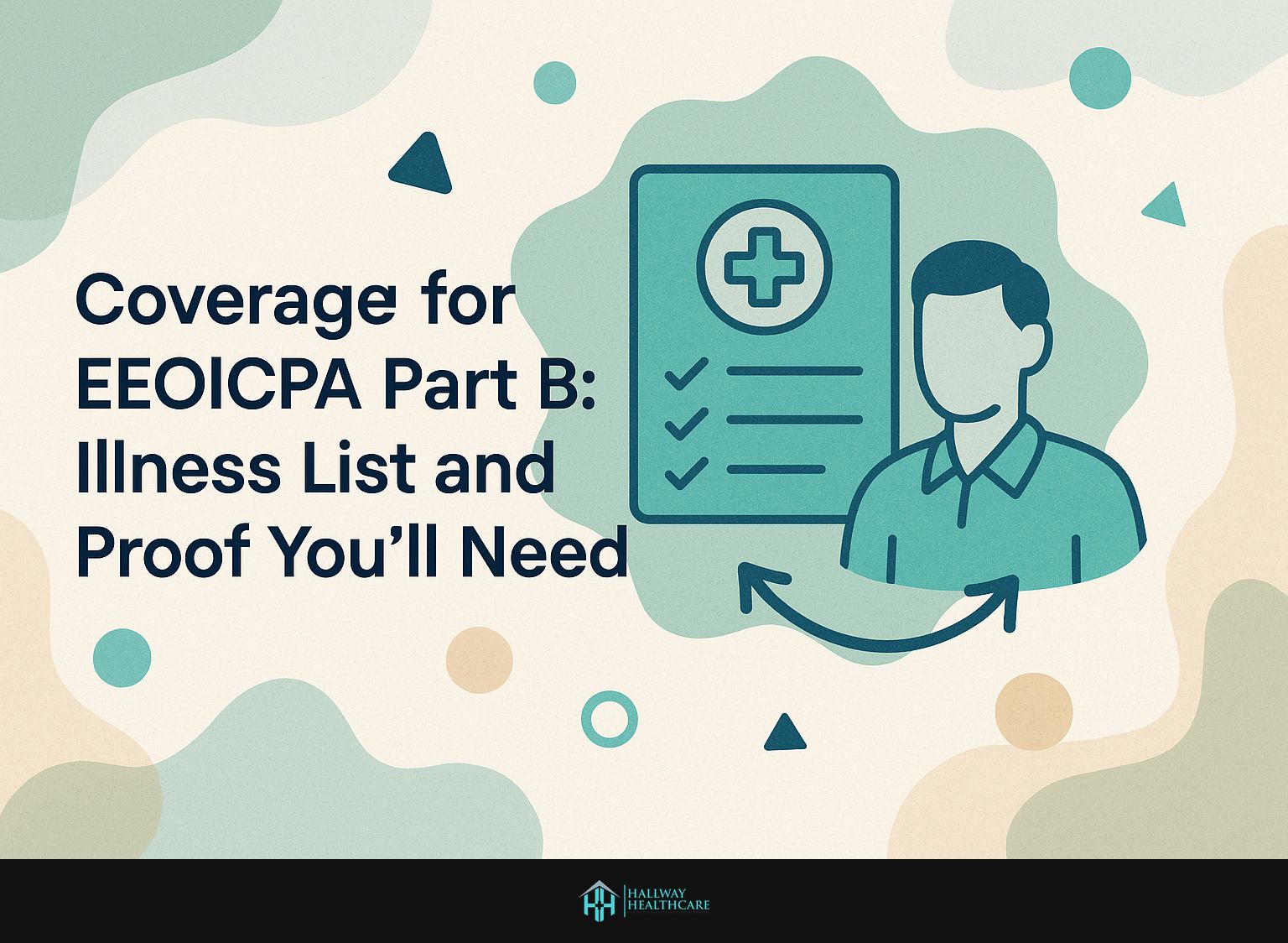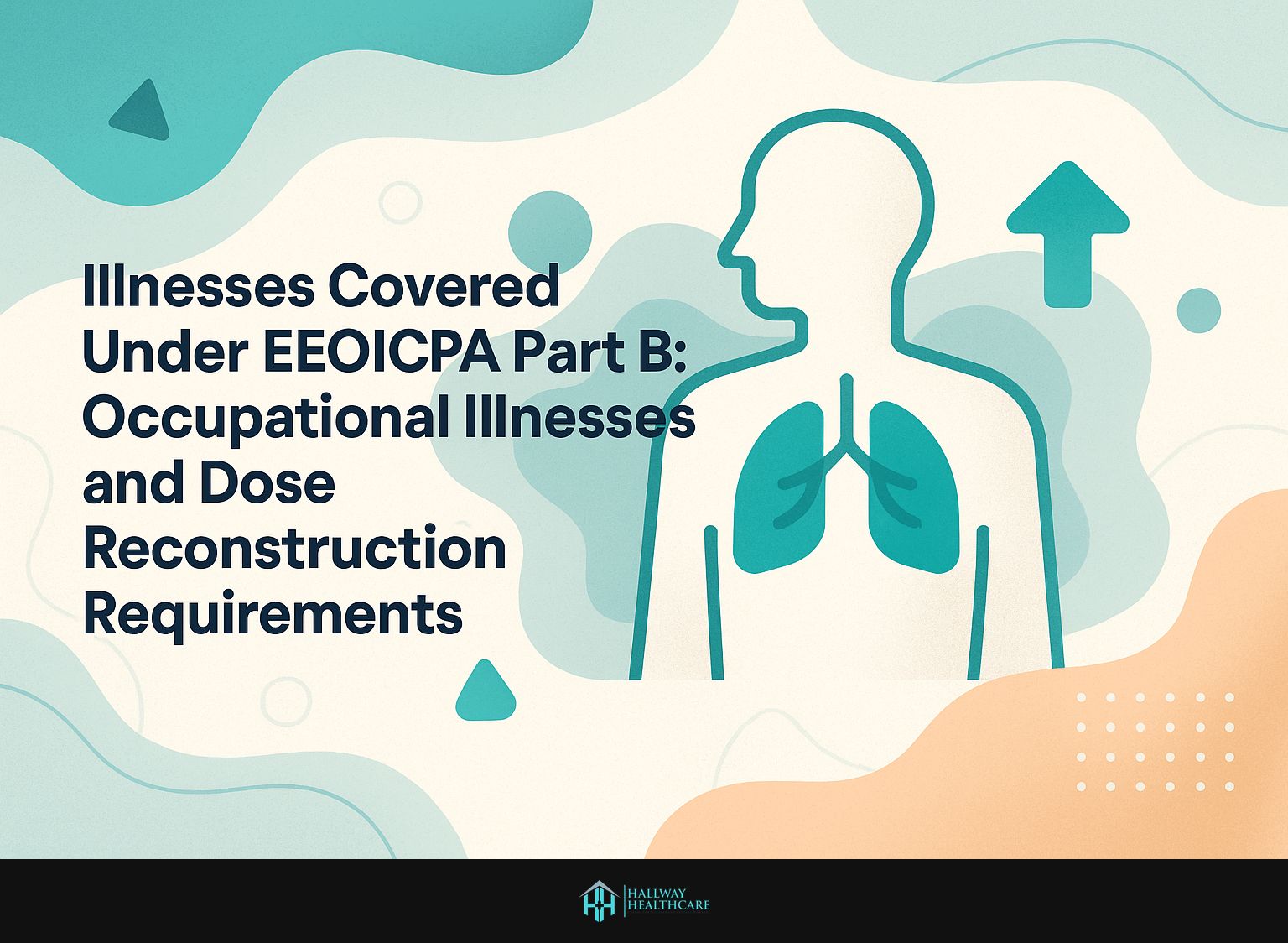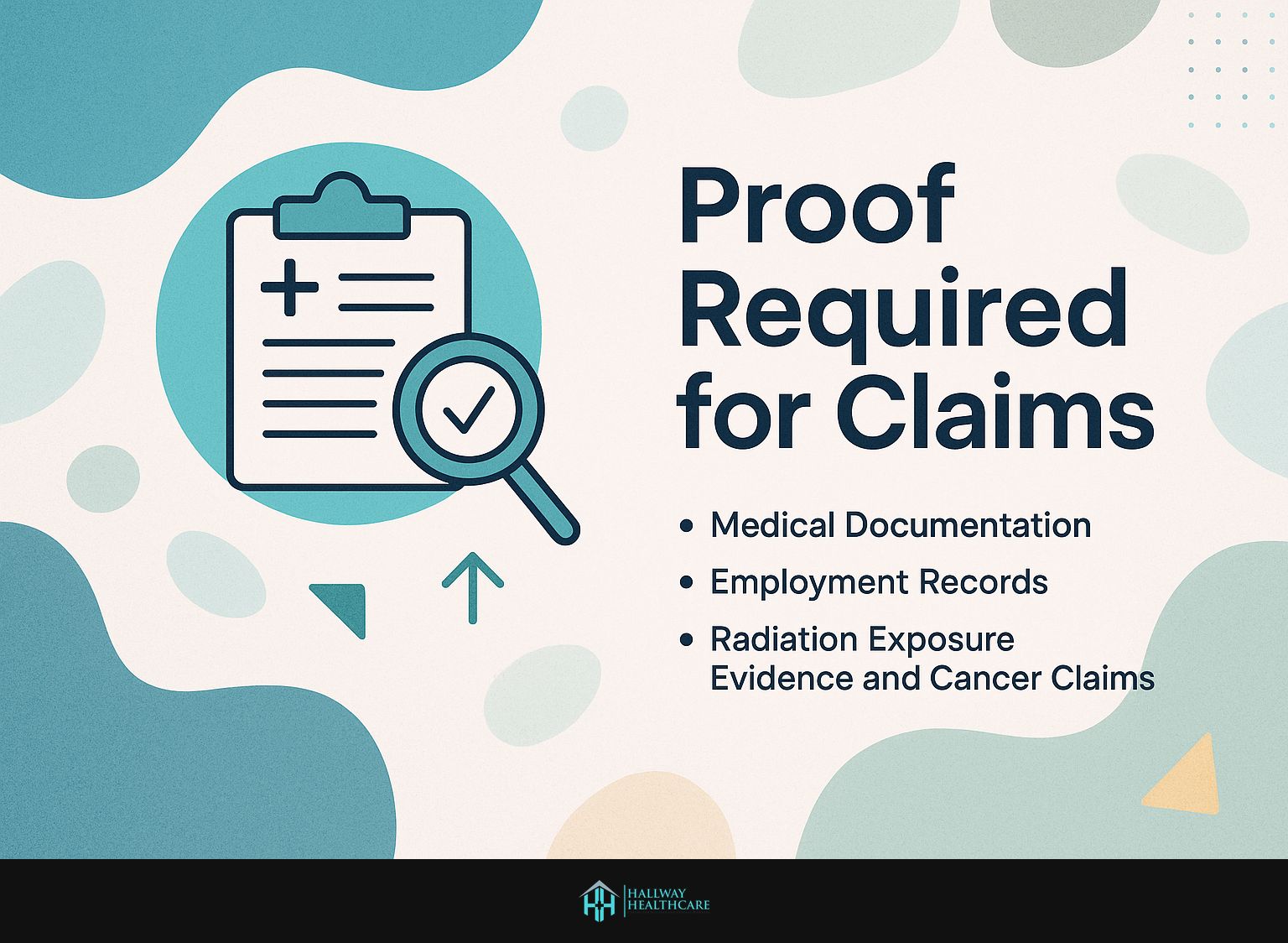
Understanding EEOICPA Part B is crucial for those impacted by serious illnesses like chronic beryllium disease, beryllium sensitivity, chronic silicosis, and lung cancer. This program, managed by the Department of Energy, supports former workers exposed to hazardous materials and guides you through the claims process. The EEOICPA helps workers cover medical expenses and lost wages. It also provides resources for recovery.
Key Takeaways:
- EEOICPA Part B provides compensation and medical benefits to eligible individuals affected by illnesses caused by exposure to radiation.
- The list of covered illnesses is determined by specific criteria and includes examples such as cancer, beryllium disease, and chronic silicosis.
- To apply for benefits, individuals must provide medical documentation, employment records, and evidence of radiation exposure. Common mistakes should be avoided in the application process.
Overview of EEOICPA
Established in 2000, the Energy Employees Occupational Illness Compensation Program Act (EEOICPA) provides compensation to employees of the Department of Energy (DOE) who suffer from illnesses related to occupational exposure to radiation and toxic substances. This program helps workers by covering medical expenses and lost wages. It also offers resources for recovery.
Key components of the EEOICPA include the provision for filing claims for both uranium miners and workers affected by the nuclear weapons program. It is essential for eligible individuals to be aware of the required documentation, such as medical records and employment history, as this can significantly expedite the claims process.
This program not only provides financial relief but also acknowledges the sacrifices of workers suffering from chronic illnesses due to hazardous conditions.
Purpose of Part B: Special Exposure Cohort Considerations and Compensation Benefits
Part B of the Energy Employees Occupational Illness Compensation Program Act (EEOICPA) specifically addresses the provision of benefits to employees who have experienced chronic beryllium disease and other significant health issues associated with their work environments. Part B addresses benefits for employees with chronic beryllium disease and other health issues from their work. It includes medical benefits for necessary treatments and lump-sum payments for eligible claimants.
Part B focuses on health issues linked to beryllium exposure, while other EEOICPA components cover a broader range of conditions.
To qualify for benefits, employees must show a clear link between their health issues and work history. This ensures support for those most affected.
Illnesses Covered Under EEOICPA Part B
EEOICPA Part B covers illnesses like chronic beryllium disease and various cancers, including lung cancer, renal cancer, and multiple myeloma. This program offers essential support for those affected by workplace toxic exposure.

List of Covered Illnesses
The covered cancers under EEOICPA (Energy Employees Occupational Illness Compensation Program Act) Part B include chronic beryllium disease, various cancers such as lung cancer, renal cancer, and multiple myeloma, among others. These conditions have substantial implications for occupational health.
Chronic beryllium disease is a serious respiratory condition. It results from inhaling beryllium, affecting workers in sectors like aerospace and electronics. Lung cancer is common among those exposed to hazardous substances. This condition can lead to serious health challenges and job loss.
Additionally, renal cancer is linked to exposure to certain chemicals. Multiple myeloma, a type of blood cancer, can develop in those exposed to specific toxins, including uranium miners.
Raising awareness and maintaining documentation of these conditions is vital for securing workers’ compensation. This effort also promotes safer workplace environments.
Worker Eligibility and Employment Proof
To qualify for EEOICPA Part B benefits, claimants must meet specific criteria. This includes showing a direct link between their illness and their employment with the Department of Energy or its contractors.
Claimants must provide the following documentation:
- Employment records
- Medical reports detailing the diagnosed illness
- Evidence linking the illness to employment-related exposure
Filing claims quickly is crucial. Claims should be submitted as soon as possible after diagnosis. While claimants have up to 30 years post-employment to apply, submitting claims sooner can expedite the process and enable more timely access to benefits.
Examples of Covered Illnesses
Covered illnesses under EEOICPA Part B include chronic beryllium disease and various cancers, such as lung and renal cancer. Chronic beryllium disease significantly impacts lung function.
Chronic beryllium disease (CBD) presents as lung inflammation and scarring, resulting in symptoms such as chronic cough and shortness of breath. According to the Centers for Disease Control and Prevention (CDC), CBD affects approximately 2% of workers who have been exposed to beryllium.
Similarly, lung cancer, which is linked to workplace exposure to radioactive materials, exhibits a higher incidence in certain industries, particularly among uranium miners. Research indicates that these individuals face a 4 to 7 times greater risk of developing lung cancer compared to the general population.
These illnesses have serious health impacts. They can restrict daily activities, mobility, and the ability to work.
Eligibility Rules
It is essential for claimants seeking benefits under EEOICPA Part B to thoroughly understand the eligibility criteria to ensure they meet the necessary requirements.
Eligible Applicants
Eligible applicants include current and former Department of Energy employees and contractors. They must have developed covered illnesses due to their work exposure.
Individuals who worked for the Department of Energy in roles at nuclear facilities or in positions involving the handling of hazardous materials are particularly eligible. It is essential to consider the duration of employment; typically, candidates must have worked for a minimum of 250 days in roles with significant exposure.
Retirees who can provide evidence of chronic illnesses related to their on-the-job conditions may also qualify. Applicants are strongly encouraged to compile medical documentation that supports their claims, as this can significantly improve their likelihood of approval.
Requirements for Illness Claims
To file an illness claim under EEOICPA Part B, applicants must provide clear documentation. This should show their work history and the illness linked to their exposure.
Applicants should compile essential documents, including a completed Form EE-1 (Claim for Benefits), detailed medical records pertaining to the illness, and evidence of employment such as pay stubs or job descriptions.
Follow this checklist to streamline the process:
- Accurately complete Form EE-1.
- Obtain medical documentation from healthcare providers.
- Collect employment records from former employers or the Department of Labor.
It is also wise to keep copies of all submitted documents for future reference. The submission process typically requires 60 to 90 days for adjudication.
Required Proof for Claims
Claimants must compile evidence to support their claims under EEOICPA Part B. This includes the collection of medical documentation, employment records, and proof of exposure.

Medical Documentation
Strong medical documentation is key to validating claims under EEOICPA Part B. This process requires the inclusion of detailed medical records and diagnoses from qualified healthcare professionals.
To meet these requirements, you must include specific types of documentation. These include discharge summaries, pathology reports, and progress notes.
Each document must clearly state the diagnosis, treatment plans, and follow-up care.
Consistency in documentation is crucial. Ensure similar cases are recorded uniformly to facilitate efficient claim reviews.
Importance of Employment Records
Employment records are crucial in establishing the eligibility of claimants, as they provide a comprehensive account of their employment history and exposure to hazardous substances.
Claimants should gather specific documents to support their claims. This includes pay stubs showing earnings and employment duration, along with job descriptions that outline work nature and exposure risks.
Claimants can obtain pay stubs by contacting their employer’s payroll department. They can also access them through payroll software like ADP or Paychex.
Acquiring job descriptions may necessitate reaching out to the Human Resources department for historical records or consulting existing employee handbooks. It is imperative that all documentation is accurate and complete to strengthen the validity of the claim.
Evidence of Radiation Exposure for Cancer Claims
Providing evidence of radiation exposure is essential for claimants, often necessitating detailed records from the Department of Energy or relevant monitoring programs. Claimants can compile evidence through dosimetry reports and exposure logs, which document personal radiation levels over time.
To obtain these records, contact the DOE’s Office of Worker Advocacy. Provide details like your employment history and the specific radiation monitoring programs you participated in.
Additionally, utilizing resources like the National Personnel Records Center can facilitate access to military service records that may contain relevant exposure information. This comprehensive approach significantly strengthens the case for validating claims.
Navigating the Application Process
Navigating the application process for EEOICPA Part B can be intricate, necessitating meticulous attention to detail to ensure that all required information is accurately submitted. Understanding compensation eligibility and potential lump sum payments is also important.
How to File a Claim
Filing a claim under EEOICPA Part B involves several key steps. These include gathering documentation, completing forms, and submitting them to the right agency. This process is crucial for cancer compensation and exposure-related illnesses.
Initially, it is important to collect necessary documentation, such as employment records and medical evidence related to toxic exposure.
Subsequently, one must complete Form EE-1, which serves as the primary claim application. Depending on individual circumstances, additional forms, such as Form EE-3 (for employment history), may also be required.
Upon completion, the forms and documentation should be submitted to the Department of Labor, preferably using certified mail to ensure tracking.
Keep copies of all submitted materials. Follow up within a few weeks to confirm receipt.
Common Mistakes Claimants Make
Understanding common errors in the application process is essential for claimants to avoid unnecessary delays or denials of benefits under EEOICPA Part B. Frequent mistakes include submitting incomplete documentation, failing to provide adequate medical evidence, and missing application deadlines.
To prevent incomplete submissions, it is advisable to create a checklist based on the requirements specified by the Department of Labor. In terms of medical evidence, claimants should compile all relevant medical records and ensure they are properly signed by the appropriate healthcare providers.
Additionally, setting reminders for all deadlines is crucial; utilizing a calendar application such as Google Calendar can be an effective method for tracking important dates.
These steps can streamline the application process. They improve the chances of a successful claim.
Understanding Claim Review and Approval
The claim review and approval process for EEOICPA Part B is comprehensive, ensuring that all claims are evaluated equitably and accurately based on the evidence provided.
Claim Evaluation Process
Claims under EEOICPA Part B are reviewed based on the illness severity and links to occupational exposure. Evaluators assess medical records, employment histories, and any documented hazardous substance exposure. For example, if it is a claim for respiratory issues, relevant evidence includes job roles with asbestos exposure and medical diagnoses like lung disease or skin cancer.
Resources like the National Institute for Occupational Safety and Health (NIOSH) database help identify exposure risks. This comprehensive evaluation process ensures that claims are substantiated, leading to equitable decisions based on the evidence presented.
Timeline for Claim Processing
Claim processing timelines under EEOICPA Part B can vary. They usually range from several weeks to several months based on the claim’s complexity. The process generally unfolds in three stages:
- The initial submission phase may take approximately 1 to 2 weeks as claimants gather and submit the necessary documentation, considering the risk factors and potential emotional and financial toll involved.
- The review stage can last anywhere from 4 to 12 weeks, contingent upon the detail required for the specific case; during this period, the reviewing agency evaluates the information provided.
- The decision phase may require an additional 2 to 4 weeks.
To check your claim status, use the online claim tracker from the Department of Labor for real-time updates.
Appealing a Denied Claim
For claimants whose claims have been denied under the EEOICPA Part B, it is essential to comprehend the appeal process in order to pursue the benefits to which they are entitled.
Reasons for Denial
Claims can be denied for several reasons, including insufficient medical documentation, lack of proof of exposure, or not meeting eligibility criteria. To minimize the risk of denial, claimants should ensure that comprehensive medical records detailing their diagnoses and treatments are collected and submitted effectively.
For instance, getting a detailed report from a doctor specializing in occupational diseases is crucial. Including documented evidence of exposure, such as a work history that indicates handling hazardous materials, can significantly strengthen the case.
Additionally, claimants must review the eligibility requirements to ensure they meet all criteria, including being diagnosed with a covered condition linked to their job.
Steps to Appeal
Appealing a denied claim under EEOICPA Part B involves clear steps, including preparing additional documentation and re-filing the claim.
- First, it is essential to carefully review the denial letter in order to comprehend the reasons underlying the decision.
- Subsequently, relevant evidence should be gathered, which may include medical reports, employment records, and witness statements that substantiate the case.
- File the appeal within 60 days of the denial using Form EE-1. Include a cover letter summarizing your arguments.
- Additionally, it is advisable to maintain copies of all documents for personal records.
- Regularly tracking the status of the appeal is encouraged, as processing can extend over several months.
Final Thoughts on EEOICPA Part B
Navigating EEOICPA Part B can be challenging. Understanding its processes is key to securing your entitled benefits. Covered conditions like leukemia and multiple myeloma should be carefully documented.
It is advisable to begin by familiarizing oneself with the key eligibility criteria, which include being a covered employee who has worked in a specified facility.
Collect necessary documentation, like employment records and medical histories, to support your claim.
Use resources like the Department of Labor’s website for detailed guidelines. Tools like the EEOICPA Claims Assistant help track your claim’s progress.
Additionally, connecting with advocacy groups, such as workers’ compensation attorneys or local veterans’ organizations, may offer valuable support.
Using these resources can greatly improve your chances of a successful claim.
 Skip to content
Skip to content
